Camera Trapping the Florida Panther
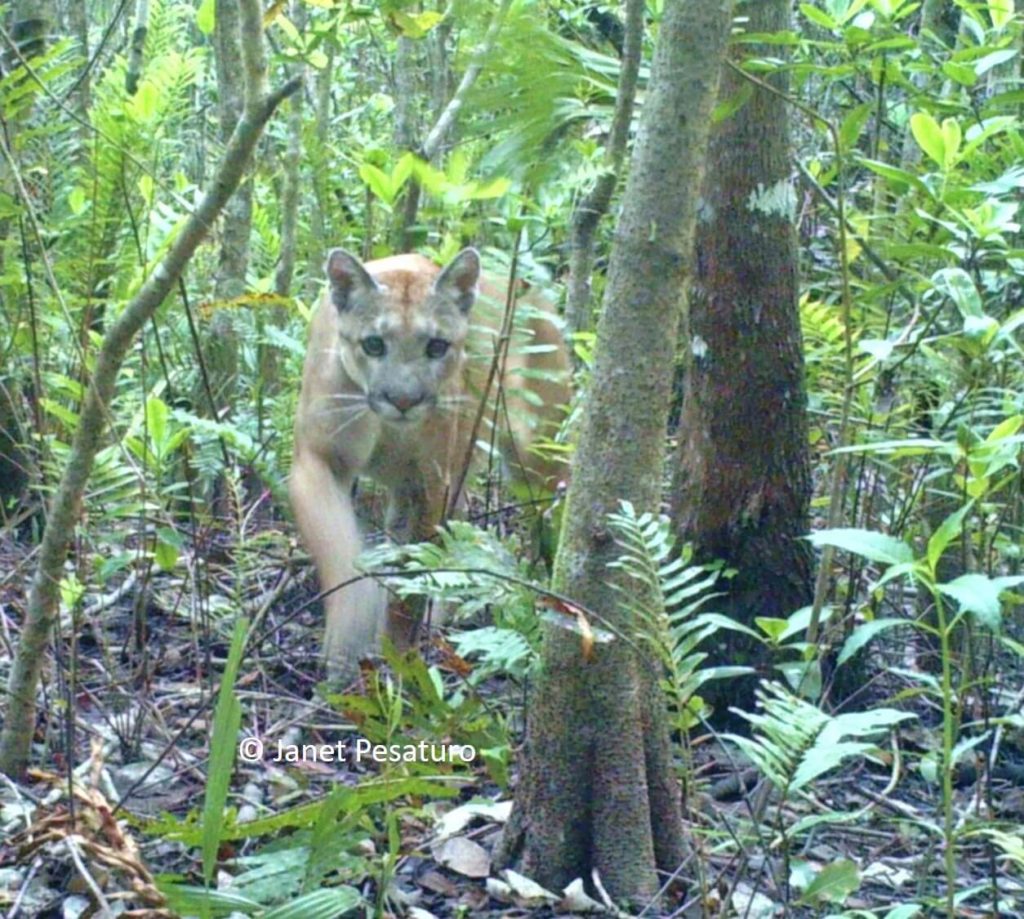
Florida panther using a game trail in southwest Florida. Taken with an Exodus Lift trail camera.
Recently I took on the personal challenge of camera trapping the Florida panther, Puma concolor coryi, an endangered subspecies of cougar, and the only confirmed breeding population of Puma concolor in the eastern US. Estimated at about 180 adults and subadults, this population is virtually confined to south Florida. The east-west flowing Caloosahatchee River presents a formidable barrier to range expansion. Always in search of female panthers, wide ranging males occasionally cross it, but females wait for the males to come to them. They tend to remain close to their place of birth, and not one has been known to cross the river.
Camera Trapping the Florida Panther
In March, I visited southwest Florida to track panthers and station some trail cameras. This is normally the dry season, but lucky for me, it was an unusually wet winter. An abundance of muddy substrate made tracking relatively easy. The wet conditions not only facilitated tracking, but also forced the panthers to make frequent use of the old logging trams, some of which are maintained as hiking trails. I left some cameras on two different trams and one on an animal trail, and returned to the cold New England clime and waited. To my delight, I found a lot of panther photos when I collected my cameras in mid-May. Of course, most of them were butt shots, too grainy, or otherwise unappealing, but I ended up with a few winners.
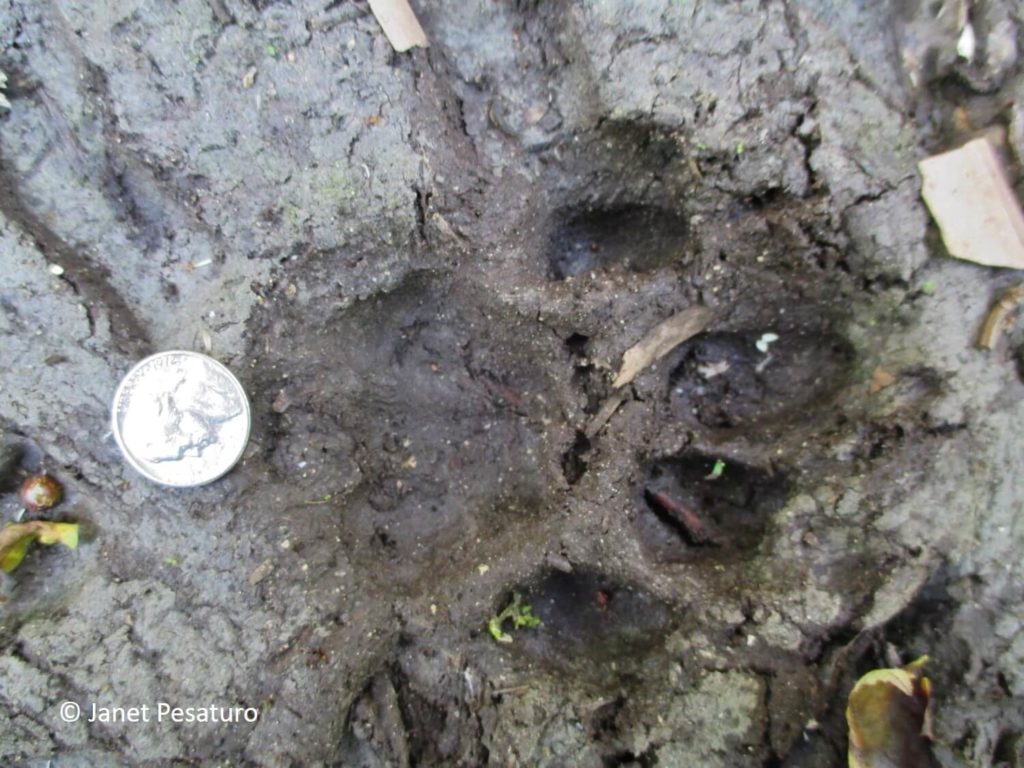
Florida panther track, found on an old logging tram, now maintained as a hiking trail, in southwest FL.
All panther photos on this page were captured with an Exodus Lift, an excellent trail camera for the money. I believe I captured 3 different individuals. One used a tram a couple of times within the 2 months I had my cameras there, and 2 traveling together used a different tram, about 10 miles away, several times. The one using the game trail (twice in 2 months) might well have been one member of the traveling pair, because the trail was off their tram.
What I learned from camera trapping panthers
The photos revealed some interesting points:
Not all of them are radio collared. Well, of course not all of them are, but I suspected that most individuals of this intensively studied, small population would have collars, and I figured the chances of photographing an un-collared cat would be slim. But my cameras captured at least two. Here is one of them: (Edit: Since publishing this, I’ve been told by a Florida wildlife enthusiast that only about 20 panthers are currently collared. So capturing the collared one was actually against the odds, not the other way around.)
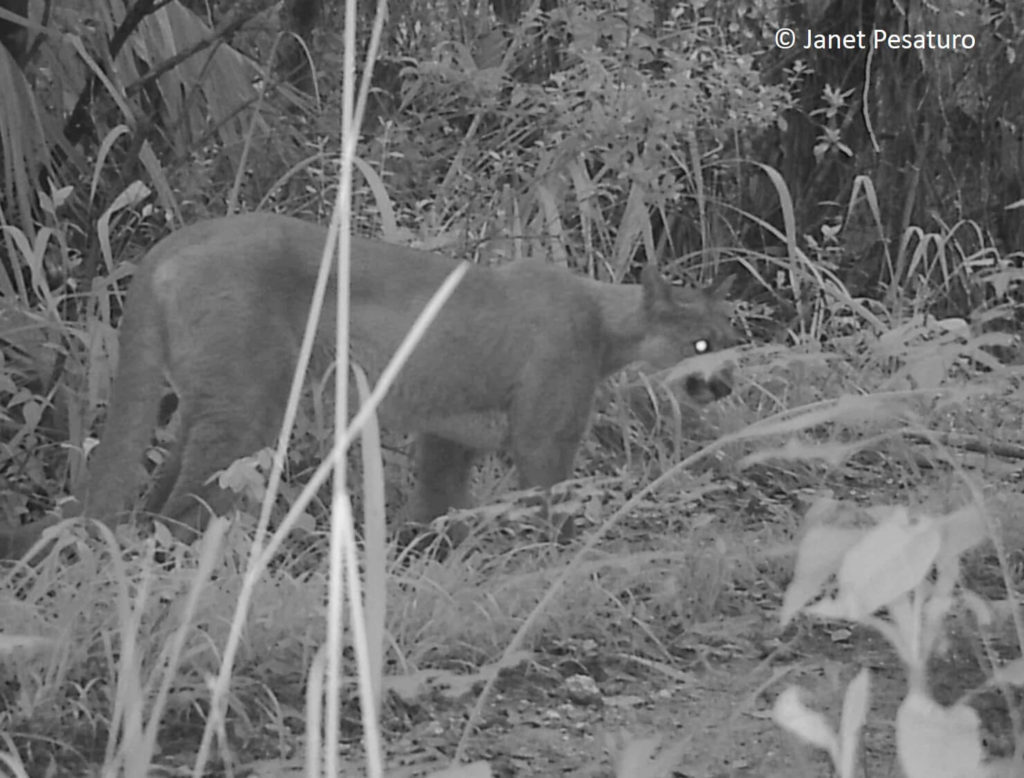
A panther with no radio collar.
Another interesting capture was a pair of panthers traveling together. Cool to see. This was probably a mother with her adolescent youngster, or a pair of litter mates hanging together after mom gave them the boot.
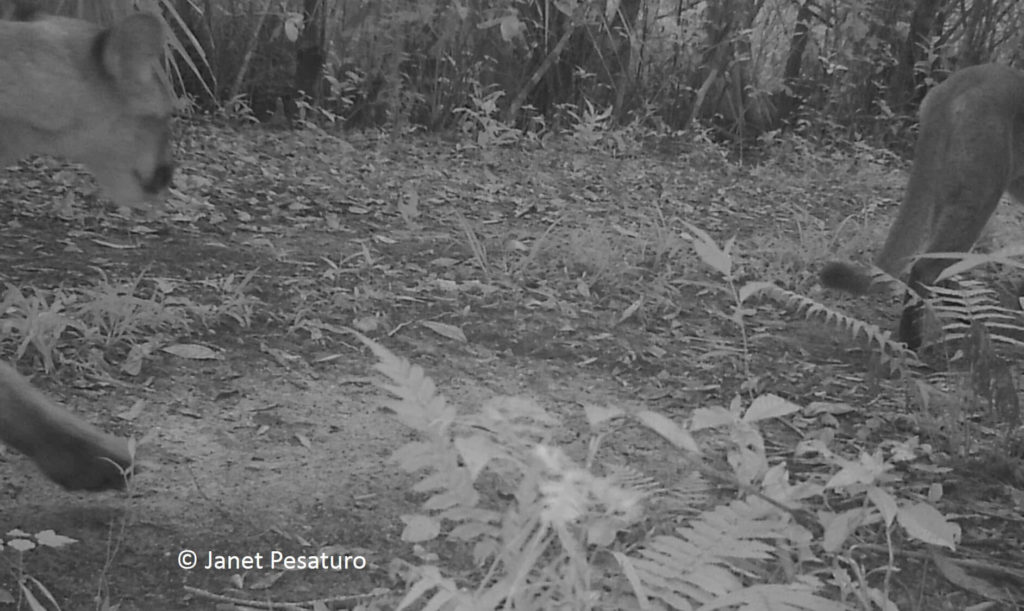
Two panthers traveling together. Neither of them sported collars.
In another area, I got a photo of a collared panther who appears to be pregnant. At least I think she is. Look at the photo below and tell me what you think. I’d love to hear from someone who has studied panthers, and willing to share an opinion on that.
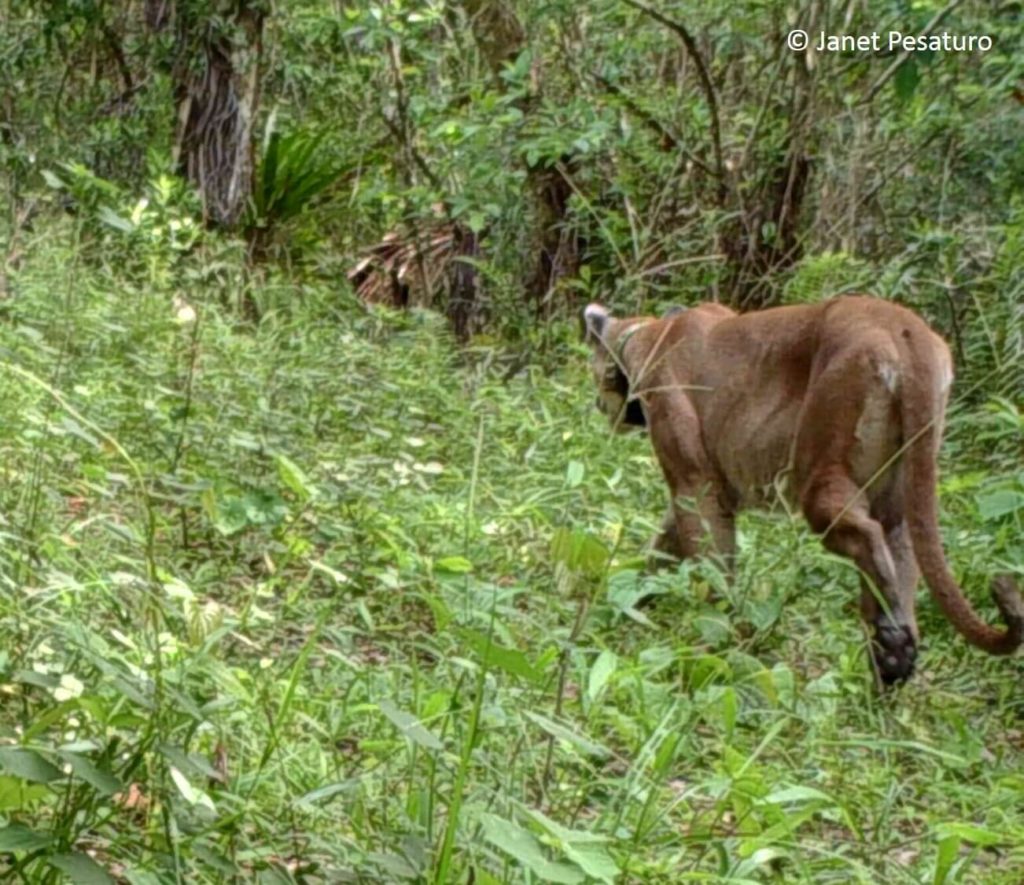
Collared Florida panther with a substantial belly. Is this a pregnant female?
In the 1980’s, biologists noticed that many individuals within the small, isolated cougar population of southwest Florida had a variety of genetic abnormalities, suggestive of inbreeding depression. These included kinked tail, undescended testicles, atrial septal defects, and cowlicks. To improve genetic diversity, they released 8 female Texas cougars in south FL in the mid 1990’s. Apparently, it helped. The panther in the next photo appears to have a normal tail. In fact, I did not notice kinks in the tails of any panthers photographed. Read more about Florida Panther Genetics.
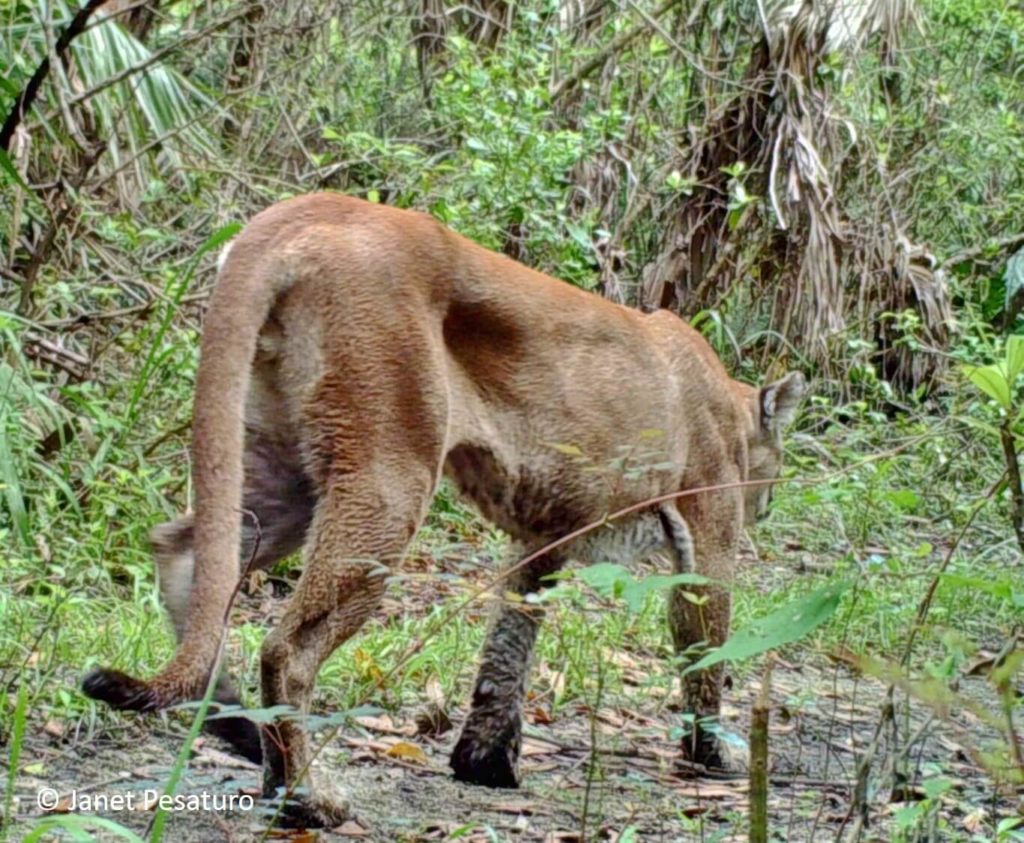
This panther does not appear to have a kinked tail. It was photographed on the same tram as the one where 2 panthers were traveling together, and I suspect it is one of those individuals.
Florida panther conservation and how you can help
This small, isolated population is severely threatened by pressures to develop land within and around panther country. A recent study (Frakes, et al. 2015 Landscape Analysis of Adult Florida Panther Habitat. Public Library of Science) concluded that the situation was even more dire than previously thought, and stated that “all remaining breeding habitat in south Florida should be maintained, and the current panther range should be expanded into south-central Florida”.
Fortunately conservation groups are working to protect panther habitat, most notably The Nature Conservancy of Florida. Recently they protected a critical piece along the Caloosahatchee River and seek to protect another 7,300 acres of prime panther habitat which will connect to existing green space to panther territory. Read more about their efforts and accomplishments, and consider supporting them, here.

That’s some amazing photos
Thanks, Don, it was exciting to get them!
Amazing. I didn’t know they still exist. How wonderful.
Yes, it is wonderful that they’ve managed to persist, but unfortunately their future is severely threatened by rapid loss of habitat to development, as well as anti-predator sentiments.
I lived in the Oaks, Sarasota for a few years…highly residential. Panthers came through regularly. Are they adjusting to development?
Hi Bill, panthers (= mountain lion = puma = cougar = catamount) are quite tolerant of and can live around humans, as long as humans don’t kill them or destroy their habitat. They can live in residential areas as long as there is plenty of large prey, such as deer, but people need to make an effort to coexist. Here is nice publication by FL F&W on living with panthers: https://myfwc.com/media/3112/livingwithpanthers.pdf
Nice work and article Janet!
Thank you, Jim!
excellent, nice work!
I am glad no hiker walked off with your cameras.
Thanks, Richard! I too was glad and surprised that no one stole a camera. At the time it was so wet that one couldn’t travel off the trams without wading in alligator infested swamps, so there was really no choice. I did choose very lightly used trams, not the main ones that most hikers use. Still lucky though.
Nice work Janet! Just getting around to reading this.
Thanks, Jim. I wish I could return to South FL to photograph this species with the cameras I have now, which take better quality images.